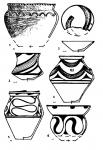Summary (English)
The Tripolye settlement of Kolodyste 2 has been known since 1890’s. Surveys at the territory of this site directed by Kruts were conducted by the Tripolye expedition of the Institute of Archaeology of the NAS of Ukraine in 1980’s.
Two burnt houses of the Tripolye culture were investigated. The remains of the houses (so-called ploshchadka ) are represented by compact clusters of burnt daub and pottery. Their measure is, respectively, 10.6 × 6.2 m and 10.6 × 6.0 m. The two-storeyed Eneolithic houses were ritually burnt. Interpretation of the houses is debated. Ryzhov interprets ploshchadka 1 as a one-storeyed dwelling and_ploshchadka_ 2 as a two-storeyed house, while Chernovol interprets both dwellings as two-storeyed houses (cf. Ryzhov et al. 2005; Chernovol 2011).
The majority of finds is represented by table pottery and kitchen ware. Kitchen wares represented by pots and bowls reached 2 % of the total number of ceramics. Table wares, c. 98 % of the total number of ceramics, are represented by semi-spheric and conical bowls, goblets, biconical and sphero-conical vessels, helmet-shaped lids, craters and pots. Table wares have monochromic black painted ornamentation. Pottery seriation confirmed earlier the preliminary conclusion of Ryzhov (1993) considering the relative chronology of this site, which belonged to the second phase of the Nebelivska local group. Later spatial analysis of sites in the Southern Buh and Dnipro interfluve made possible the destabilization of the chronological sequences (Diachenko and Menotti 2012). Kolodyste 2 was associated with the first stage of the second phase of the Nebelivska local group.
Other finds are represented by anthropomorphic and zoomorphic figurines made of clay, clay beads and tools made of flint, bone and horn. Several tools made of stone are associated with agricultural activities, for instance grinding stones.
Primary source of information / Основне джерело: Ryzhov et al. 2005.
Fig. 1. Table wares from Kolodyste 2 (after Ryzhov et al. 2005) / Рис. 1. Столова кераміка Колодистого 2 (за Ryzhov et al. 2005)






![Download [PDF]](/excavation/skins/fasti/images/results/download_sml.png)